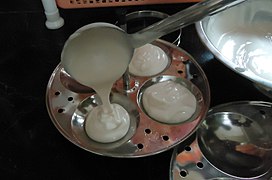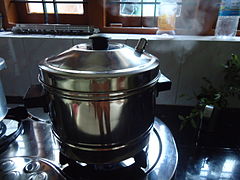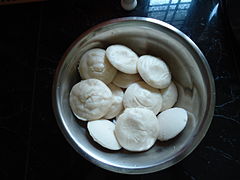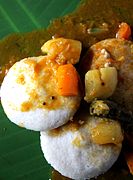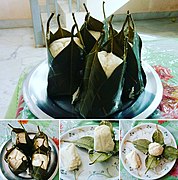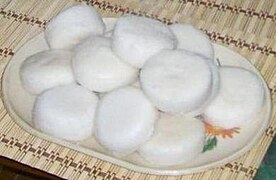Idli
 | |
| Alternative names | Idly |
|---|---|
| Course | Breakfast, dinner |
| Region or state | South India |
| Associatedcuisine | India,Sri Lanka |
| Serving temperature | Hot with a condiment such assambarorchutneyin South India,ghugniandaloo dumin East India |
| Main ingredients | Black lentils(de-husked),rice |
| Variations | Button idli, tatte idli, sanna, sambar idli, rava idli, masala idli, shell idli |
Idlioridly(/ɪdliː/) (plural:idlis) is a type of savoury rice cake, originating fromSouth India,popular as a breakfast food inSouthernIndiaand inSri Lanka.The cakes are made by steaming a batter consisting offermentedblack lentils(de-husked) and rice. The fermentation process breaks down the starches so that they are more readily metabolised by the body.
Idli has several variations, includingrava idli,which is made fromsemolina.Regional variants includesannaofKonkan.
History[edit]
A precursor of the modern idli is mentioned in several ancient Indian works.Vaddaradhane,a 920 CEKannada languagework byShivakotiacharya,mentions "iddalige", prepared only from ablack grambatter. Chavundaraya II, the author of the earliest available Kannada encyclopedia,Lokopakara(c.1025 CE), describes the preparation of this food by soaking black gram inbuttermilk,ground to a fine paste, and mixed with the clear water ofcurdand spices.[1]TheWestern Chalukyaking and scholarSomeshwara III,reigning in the area now calledKarnataka,included an idli recipe in his encyclopedia,Manasollasa(1130 CE). ThisSanskrit-language work describes the food asiḍḍarikā.In Karnataka, the Idli in 1235 CE is described as being "light, like coins of high value", which is not suggestive of a rice base.[2]The food prepared using this recipe is now calleduddina idliin Karnataka.
The recipe mentioned in these ancient Indian works leaves out three key aspects of the modern idli recipe: the use of rice (not just black gram), the long fermentation of the mix, and thesteamingfor fluffiness. The references to the modern recipe appear in the Indian works only after 1250 CE. Food historianK. T. Achayaspeculates that the modern idli recipe might have originated in present-dayIndonesia,which has a long tradition of fermented food. According to him, the cooks employed by theHindukings of theIndianised kingdomsmight have invented the steamed idli there, and brought the recipe back to India during 800–1200 CE.[3][4]Achaya mentioned an Indonesian dish called "kedli", which according to him, was like an idli.[5][3]However, Janaki Lenin was unable to find any recipe for an Indonesian dish by this name.[6]According to food historianColleen Taylor Senthe fermentation process of idli batter is a natural process that was discovered independently in India, since nearly all cultures use fermentation in some form.[7]
TheGujaratiworkVarṇaka Samuccaya(1520 CE) mentions idli asidari,and also mentions its local adaptation,idada(a non-fermented version ofdhokla).[8]
The earliest extantTamilwork to mention idli (asitali) isMaccapuranam,dated to the 17th century.[9][10]In 2015,Chennai-based Idli caterer Eniyavan started celebrating March 30 as "World Idli Day".[11]
Preparation[edit]
| Nutritional value per 1 piece (30 gm) | |
|---|---|
| Energy | 167 kJ (40 kcal) |
7.89 g | |
| Dietary fiber | 1.5 g |
0.19 g | |
| Saturated | 0.037 g |
| Monounsaturated | 0.035 g |
| Polyunsaturated | 0.043 g |
1.91 g | |
| Minerals | Quantity %DV† |
| Potassium | 2% 63 mg |
| Sodium | 9% 207 mg |
| †Percentages estimated usingUS recommendationsfor adults,[13]except for potassium, which is estimated based on expert recommendation fromthe National Academies.[14] Source:[12] | |
To make Idli, four parts uncooked rice (idli rice orparboiled rice) to one part whole white lentil (black gram,Vigna mungo) are soaked separately for at least four hours to six hours or overnight. Optionally spices such as fenugreek seeds can be added at the time of soaking for additional flavour. Once done soaking, the lentils are ground to a fine paste and the rice is separately coarsely ground, then they are combined. Next, the mixture is left to ferment overnight during which its volume will more than double. After fermentation, some of the batter may be kept as a starter culture for the next batch. The finished idli batter is put into greased moulds of an idli tray or "tree" for steaming. The perforated molds allow the idlis to be cooked evenly. The tree holds the trays above the level of boiling water in a pot, and the pot is covered until the idlis are done (about 10–25 minutes, depending on size). A more traditional method is to use leaves instead of moulds.[15]
- Making idlis
-
Key ingredients used are rice and black gram.
-
Idli batter
-
Idli mold
-
Batter poured into the mold
-
Several molds stacked over another
-
Idli steaming in cooker
-
Cooked idli
-
Molds removed from cooker
-
Idlis ready to eat
Serving[edit]
Since plain idlis are mild in taste, a condiment is considered essential. Idlis are often served withchutneys(coconut-based),sambarandMedu vada.However, this varies greatly by region and personal taste, it is also often served with kaara chutney (onion-based) orspicy fish curries.The dry spice mixturepodiis convenient while travelling.

Variations[edit]
There are several regional variations of idlis made in South India and Sri Lanka. With the emigration of south Indians and Sri Lankans throughout the region and world, many variations on idli have been created in addition to the almost countless local variations. Hard-to-get ingredients and differing cooking customs have required changes in both ingredients and methods.Parboiled ricecan reduce the soaking time considerably. Store-bought ground rice or cream of rice may also be used.[16]Similarly,semolinaorcream of wheatmay be used for preparingrava idli(wheat idli).[17]Dahi(yogurt) may be added to provide the sour flavour for unfermented batters. Pre-packaged mixes allow for almost instant idlis.[18]
In addition to or instead of fenugreek, other spices may be used such as mustard seeds, chili peppers, cumin, coriander, ginger, etc.[19]Sugar may be added to make them sweet instead of savoury. Idli may also be stuffed with a filling of potato, beans, carrot and masala.[20]Leftover idlis can be cut-up or crushed andsautéedfor a dish called idliupma.[21]A microwave or an automatic electric steamer that is non-stick is considered to be a convenient alternative to conventional stovetop steamers. Batter preparation using a manual rocking rock grinder can be replaced by electric grinders or blenders. Many restaurants have also come up with fusion recipes of idlis such as idly manchurian, idly fry, chilly idly, stuffed idly, to name a few.
-
Idlis cooked traditionally in coconut shells, Karnataka
-
Idli served withrasam
-
Moode idli steamed infragrant screwpineleaves, Mangalore, Karnataka.
-
Sambar idli as served inTamil Nadu
-
Kotte kadubu idlis steamed in jackfruit leaves, Karnataka
Batter fermentation mechanism[edit]
Fermentation of idli batter results in both leavening caused by the generation of carbon dioxide as well as an increase in acidity. This fermentation is performed by lactic acid bacteria, especially the heterofermentative strainLeuconostoc mesenteroidesand the homofermentative strainEnterococcus faecalis(formerly classified asStreptococcus faecalis). Heterofermentative lactic acid bacteria such asL. mesenteroidesgenerate both lactic acid as well as carbon dioxide whereas homofermentative lactic acid bacteria only generate lactic acid.
BothL. mesenteroidesandE. faecalisare predominantly delivered to the batter by the black gram. Both strains start multiplying while the grains are soaking and continue to do so after grinding.
L. mesenteroidestolerates high concentrations of salt unlike most other bacteria. Hence the salt in the batter and the ongoing generation of lactic acid both suppress the growth of other undesirable micro-organisms.[22][23]
Idli Day[edit]
March 30 is celebrated as World Idli Day.[24]It was first celebrated in 2015 at Chennai.[25]
See also[edit]
References[edit]
- ^Edward R. Farnworth 2003,p. 11.
- ^K. T. Achaya 1994,p. 90.
- ^abK.T. Achaya (1 November 2003).The Story of Our Food.Universities Press. pp. 80–.ISBN978-81-7371-293-7.
- ^D. Balasubramanian (21 October 2004)."Changes in the Indian menu over the ages".The Hindu.Archived fromthe originalon 6 December 2014.
- ^"Idli saga: A study into the origin of the South Indian dish".
- ^Lenin, Janaki (30 March 2012)."A tale of two sambhars".The Hindu– via www.thehindu.com.
- ^Feasts and Fasts: A History of Food in India, page 146, Colleen Taylor Sen (2015)
- ^Achyut Yagnik; Suchitra Seth (24 August 2005).Shaping Of Modern Gujarat.Penguin Books Limited. p. 24.ISBN978-81-8475-185-7.
- ^Vikram Doctor (28 April 2007)."Idli saga: A study into the origin of the South Indian dish".Economic Times.Retrieved25 August2014.
- ^K.T. Achaya (5 March 2009).The Illustrated Foods of India.OUP India.ISBN978-0-19-569844-2.
- ^"World Idli Day 2018: Here's The Intriguing Story Behind This Delicious Day".NDTV. 30 March 2018.
- ^"Calories in Idli and Nutrition Facts".www.fatsecret.co.in.
- ^United States Food and Drug Administration(2024)."Daily Value on the Nutrition and Supplement Facts Labels".FDA.Archivedfrom the original on 27 March 2024.Retrieved28 March2024.
- ^National Academies of Sciences, Engineering, and Medicine; Health and Medicine Division; Food and Nutrition Board; Committee to Review the Dietary Reference Intakes for Sodium and Potassium (2019). Oria, Maria; Harrison, Meghan; Stallings, Virginia A. (eds.).Dietary Reference Intakes for Sodium and Potassium.The National Academies Collection: Reports funded by National Institutes of Health. Washington, DC: National Academies Press (US).ISBN978-0-309-48834-1.PMID30844154.Archivedfrom the original on 9 May 2024.Retrieved21 June2024.
- ^"Idlis in jackfruit leaves".Aayi's Recipes.2006.Retrieved14 October2014.
- ^"Idli using Cream of Rice".Edibly Asian.Retrieved14 October2014.
- ^Geeta, Seth."Rava Idli: (Cream of wheat or sooji idli)".North India Cooking.Retrieved14 October2014.
- ^"instant idli mix".Tarla Dalal.Sanjay & Co.Retrieved14 October2014.
- ^Rachana, Gorikapudi (2012)."Fenugreek Leaves Idli".SPICY CURRIES.Retrieved14 October2014.
- ^"Stuffed Idli".Spicy Tasty.2013.Retrieved14 October2014.
- ^"Idli Upma Recipe-Recipe with Leftover idlis".Padhu's Kitchen.2012.Retrieved14 October2014.
- ^VEEN, A. G.; HACKLER, L. ROSS; STEINKRAUS, K. H.; MUKHERJEE, S. K. (28 June 2008). "Nutritive Quality of Idli, a Fermented Food of India".Journal of Food Science.32(3): 339–341.doi:10.1111/j.1365-2621.1967.tb01326_32_3.x.ISSN0022-1147.
- ^Council, National Research (1 January 1992).Applications of Biotechnology in Traditional Fermented Foods.doi:10.17226/1939.ISBN978-0-309-04685-5.PMID25121339.
- ^Agrawal, Saumya."World Idli Day".Times Now News.Retrieved30 March2022.
- ^Saha, Somdatta."World Idli Day 2021".NDTV Food.Retrieved30 March2022.
Bibliography[edit]
- K. T. Achaya(12 May 1994).Indian Food: A Historical Companion.Oxford University Press, USA.ISBN978-0-19-563448-8.
- Devi, Yamuna (1987).Lord Krishna's Cuisine: The Art of Indian Vegetarian Cooking,Dutton.ISBN0-525-24564-2.
- Edward R. Farnworth (2003).Handbook of Fermented Functional Foods.CRC Press.ISBN978-0-8493-1372-1.
- Jaffrey, Madhur (1988).A Taste of India,Atheneum.ISBN0-689-70726-6
- Rau, Santha Rama (1969).The Cooking of India,Time-Life Books.




